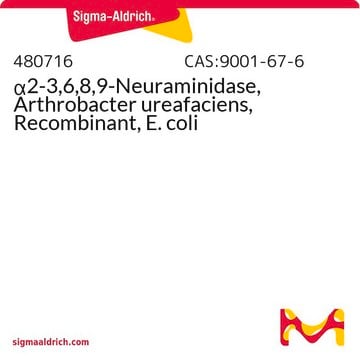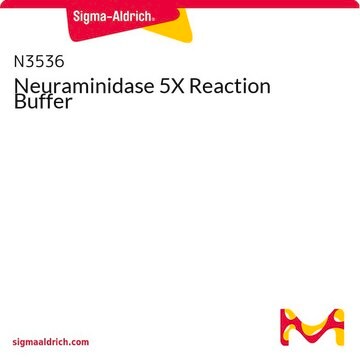10269611001
Roche
Neuraminidase (Sialidase)
from Arthrobacter ureafaciens
Synonim(y):
PCR, taq
About This Item
Polecane produkty
pochodzenie biologiczne
bacterial (Arthrobacter ureafaciens)
Poziom jakości
Postać
solution
aktywność właściwa
~25 units/mg protein
opakowanie
pkg of 1 U (100 μl)
producent / nazwa handlowa
Roche
optymalne pH
5.0-5.5
temp. przechowywania
2-8°C
Opis ogólny
Specyficzność
Zastosowanie
- cell surface lectin array analysis.
- hemagglutination assays.
- cell adhesion assay.
- detection of the cell surface glycosylations in human anaplastic large cell lymphoma cells
- release of sialic acid from cells
- antibody-overlay lectin microarray
Właściwości fizyczne
Postać fizyczna
Uwaga dotycząca przygotowania
Inne uwagi
Hasło ostrzegawcze
Warning
Zwroty wskazujące rodzaj zagrożenia
Zwroty wskazujące środki ostrożności
Klasyfikacja zagrożeń
Skin Sens. 1
Klasa zagrożenia wodnego (WGK)
nwg
Temperatura zapłonu (°F)
does not flash
Temperatura zapłonu (°C)
does not flash
Certyfikaty analizy (CoA)
Poszukaj Certyfikaty analizy (CoA), wpisując numer partii/serii produktów. Numery serii i partii można znaleźć na etykiecie produktu po słowach „seria” lub „partia”.
Masz już ten produkt?
Dokumenty związane z niedawno zakupionymi produktami zostały zamieszczone w Bibliotece dokumentów.
Klienci oglądali również te produkty
Protokoły
Neuraminidase can be used to cleave sialic acids from proteins. In this protocol, the enzyme from Vibrio cholerae is used on fixed cells.
Nasz zespół naukowców ma doświadczenie we wszystkich obszarach badań, w tym w naukach przyrodniczych, materiałoznawstwie, syntezie chemicznej, chromatografii, analityce i wielu innych dziedzinach.
Skontaktuj się z zespołem ds. pomocy technicznej








